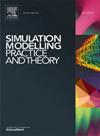Application of the multi-grid modelling method to pedestrian social group dynamics through a bottleneck
IF 3.5
2区 计算机科学
Q2 COMPUTER SCIENCE, INTERDISCIPLINARY APPLICATIONS
引用次数: 0
Abstract
There is a high proportion of social groups in crowds. The influence of social groups on crowd mobility is particularly evident in emergency situations and in confined movement environments. However, studies on the characteristics of social group movement through a bottleneck with different widths are limited. Therefore, the computation and simulation are performed in a corridor with a bottleneck involving individuals and three types of groups (namely two-person, three-person and four-person groups) using a modified multi-grid model. The original multi-grid model is modified by introducing interactions between pedestrians, avoidance behavior and group behavior, and validated by data from a controlled experiment. It is found that the group configuration can be adjusted to the changing scenarios during the passing movement. The movement efficiency and level of walking comfort for pedestrians are significantly improved in wider bottlenecks. Passing efficiency is evidently increased and congestion is reduced, when social groups occupy a large proportion of the crowd in a narrow bottleneck. These numerical findings may provide new insights for analyzing nonlinear pedestrian social group dynamics.
多网格建模方法在行人社会群体动态瓶颈中的应用
人群中有很高比例的社会群体。在紧急情况和受限的移动环境中,社会群体对人群流动的影响尤为明显。然而,对不同宽度瓶颈下社会群体流动特征的研究却十分有限。因此,采用改进的多重网格模型,在一个有瓶颈的走廊上进行计算和仿真,该走廊涉及个人和三种类型的群体(即两人、三人和四人群体)。通过引入行人、回避行为和群体行为之间的相互作用,对原有的多网格模型进行了改进,并通过对照实验数据进行了验证。研究发现,该组的配置可以根据移动过程中不断变化的场景进行调整。在较宽的瓶颈条件下,行人的运动效率和行走舒适度得到显著提高。当社会群体在狭窄的瓶颈中占据较大比例的人群时,通行效率明显提高,拥堵程度明显降低。这些数值结果可能为分析非线性行人社会群体动力学提供新的见解。
本文章由计算机程序翻译,如有差异,请以英文原文为准。
求助全文
约1分钟内获得全文
求助全文
来源期刊

Simulation Modelling Practice and Theory
工程技术-计算机:跨学科应用
CiteScore
9.80
自引率
4.80%
发文量
142
审稿时长
21 days
期刊介绍:
The journal Simulation Modelling Practice and Theory provides a forum for original, high-quality papers dealing with any aspect of systems simulation and modelling.
The journal aims at being a reference and a powerful tool to all those professionally active and/or interested in the methods and applications of simulation. Submitted papers will be peer reviewed and must significantly contribute to modelling and simulation in general or use modelling and simulation in application areas.
Paper submission is solicited on:
• theoretical aspects of modelling and simulation including formal modelling, model-checking, random number generators, sensitivity analysis, variance reduction techniques, experimental design, meta-modelling, methods and algorithms for validation and verification, selection and comparison procedures etc.;
• methodology and application of modelling and simulation in any area, including computer systems, networks, real-time and embedded systems, mobile and intelligent agents, manufacturing and transportation systems, management, engineering, biomedical engineering, economics, ecology and environment, education, transaction handling, etc.;
• simulation languages and environments including those, specific to distributed computing, grid computing, high performance computers or computer networks, etc.;
• distributed and real-time simulation, simulation interoperability;
• tools for high performance computing simulation, including dedicated architectures and parallel computing.
 求助内容:
求助内容: 应助结果提醒方式:
应助结果提醒方式:


